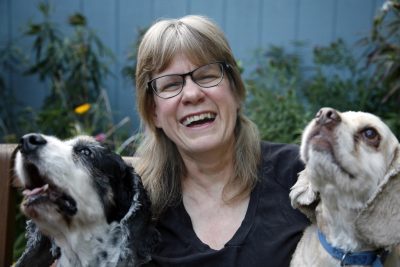Anyone who’s owned an older dog knows that feeling of panic when they pet their dog and find a lump. Is it cancer or just a fatty tumor? We try to feel if it’s isolated or connected, hard or soft. Every time we pet the dog we feel for it, trying to gauge if it’s getting bigger—and if we should make a special appointment to see the vet.
If you’ve owned a senior dog, you’ve likely had this dilemma—AND felt so relieved when the vet says, “It’s just a fatty tumor.”

What is a fatty tumor?
Fatty tumors, or Lipomas, grow under the skin and form a soft mass. Some may stay small, but others can get quite large. Most grow slowly and never break the skin unless they are in an area that may get rubbed often, such as the arm pit. The skin covering the fatty tumor does not darken or become hairless, even as the tumor grows.
These tumors are not cancerous and are just a large clump of fat cells that happen to grow together. Fatty tumors typically grow in senior dogs that are overweight. Certain breeds tend to be more pre-disposed to them, such as cocker spaniels (which I’ve had a few). Other breeds include Labradors, Shetland sheepdogs, dachshunds, weimaraners, miniature schnauzers and Doberman pinschers.
Your vet will do a fine needle aspirate of the fatty tumor and look at it under a microscope to make sure that it contains fat cells and not cancerous ones. You can see how this analysis is done in this video.
Often a pet that develops one fatty tumor will develop more.
Should fatty tumors be removed?
Unless the fatty tumor is very large, or is impeding movement, surgical removal is not necessary. These growths are not typically painful, but if they grow on the chest or legs, they may make movement difficult.
My mom euthanized an old beagle because a fatty tumor on his chest had grown very large and impeded his movement. The dog was over twelve years old and very arthritic, so my mom decided it was just his time, although she wished she had surgery performed a year or two earlier when it was much smaller. When another of her dogs developed a fatty tumor on his chest, she wanted the tumor removed, even though the vet thought it was unnecessary. That dog was Chipper, a cocker spaniel that I inherited when my mom passed away. The tumor never got bigger and was never removed. Chipper did lose about eight pounds (20% of his weight) after he came to live with me and some fatty tumors do shrink when the dog loses weight.
What causes fatty tumors?
No one seems to know, although they are more common in overweight, senior pets. Hypothyroidism may also be a leading factor. Dog’s Naturally Magazine states that fatty tumors may develop when our dog is exposed to toxins from vaccines, flea and tick medications, pesticides, herbicides, and other contaminants. Diet may lead to fatty tumor development and they recommend a fresh food diet. Also the article mentions several herbs that may be used to shrink fatty tumors. Read more about how to prevent or shrink fatty tumors here.
Read more about fatty tumors with these links:
https://www.1800petmeds.com/education/fatty-tumors-lipomas-symptoms-dogs-48.htm
https://www.bluecross.org.uk/pet-advice/fatty-lumps-and-lipomas-dogs
If you find a tumor on your pet, it’s best to have your veterinarian check it out as soon as possible to make sure it is a fatty tumor and not cancerous.
Have you had a pet with fatty tumors? What did you do?


Yes, definitely separate to know for sure what’s going on. I have found that there seems to be a link with vaccinations and fatty tumors in female dogs. Our boys don’t tend to have them as much. Great piece and will share!
We’ve luckily not run into this issue with our pets, but I’ve certainly seen others who have. Definitely seems to be common with those senior puppers.
Yes, no guessing-aspirate. So important. Even if you aspirated twenty of them, it doesn’t mean the twenty-first will be the same thing. At one wellness exam, JD had three bumps which we aspirated. Three bumps, three different things–one of the mast cell tumor.
Layla does not have any fatty tumors but I do keep an eye out and will cross that bridge when and if it happens. Great post